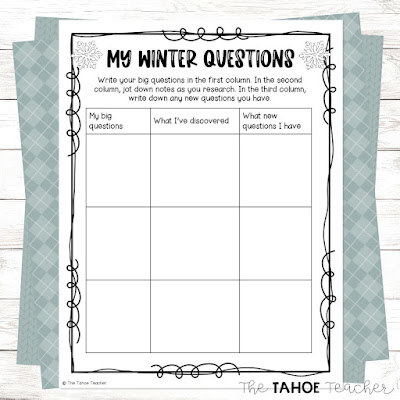Winter Unit for Inquiry and Phenomenon-Based Learning
Hey, y'all! My students are loving taking charge of their learning with our inquiry and PhenomBL units. You've probably heard about inquiry learning more so than phenomenon-based learning. If you need a recap check out these posts here and here.
One of our next big units is on winter. My students have so many questions and it's hard to get to them all. That's why these types of learning structures work so well. Students get the answers that they're looking for while also meeting our standards and learning from each other.
We start off the unit doing a little questioning session. Students look at pictures of the topic, in this case winter, and start to formulate questions based on what they see, think, and wonder about. As a class, we narrow down our top three questions, but students can always research more!
We take a look first at the weather in our area. What are the average highs and lows in winter around here? What are the current highs and lows? How do they compare?
Then we take a look at winter weather around the globe. Where is it warmer? Where is it cooler? What predictions can we make from this? We even talk about northern and southern hemispheres and how the seasons are opposite on either side of the equator.
Then, students are able to begin their research. They may delve into winter traditions around the world, winter sports that people play, animal and human adaptations to winter temperatures, and so much more. The beauty of phenomBL is that students can take their learning in any number of directions.
On any given day, research time may look like students glancing over what they did the day before and refreshing their memory on what they were working on. Then, gathering as a group on the rug to make a game plan for research time. Students work individually, with partners, or with the teacher to answer specific questions. At the end of research time, students share out any Ah-ha! moments they had or anything that they found fascinating. Other students may jot down notes to look into what their friends discovered during the next research time.
You may even wish to provide a whole class lesson or two if several students are really interested in a certain area. Most of the time though, students will be conducting research from books, online articles or videos, or hyper docs you put together specifically to answer some of their questions.
Throughout this work, students almost always come up with ideas for experiments. This is a great time to learn about the scientific method and how scientists design testable experiments. Students can create their own winter experiments (like which freezes faster, fresh or salt water, or any other number of things they can think of) and carry them out.
This winter inquiry PBL unit is full of graphic organizers, lesson ideas, writing pages, prompts, maps, graphs, and more that would be sure to last your students for several weeks. There are even reflection pages at the end if you'd like a written assessment of what students have learned.
You can check out the full unit and many more like it in my Teachers Pay Teachers store here. I'm always adding new units, so be sure to follow my store so you don't miss a thing.
I hope you found some new ideas for your classroom this year and I'll talk to you soon. Have a wonderful week.
Stay cozy,









No comments
Post a Comment